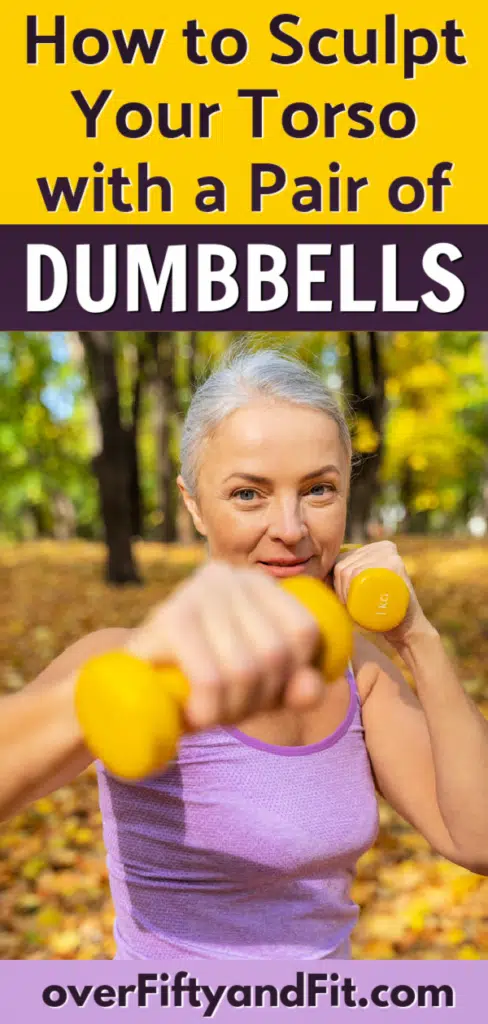Do you want a more sculpted physique? You can give your torso an excellent workout using the dumbbell. These 16 dumbbell exercises will firm, define, and strengthen your upper body.
This workout is for men or women and can be modified to match any level of fitness. Refer to the video within this article to see what it looks like to move through each exercise.
Why Using a Dumbbell is Genius
A dumbbell is a piece of strength-training equipment that consists of a short bar with two weighted ends. Dumbbells come in various weights and sizes, making them versatile for a wide range of people and movements.
Dumbbells are commonly used in strength training exercises to target various muscle groups. They can also be used in functional training exercises to improve overall fitness, balance, and stability.
The dumbbell continues to be the most effective tool for sculpting the human body’s torso muscles.
A dumbbell is usually a safer and more convenient alternative to a barbell. When used correctly, it can help correct muscular asymmetry:
- Most people are challenged with one muscle slightly larger than its other – one shoulder, or one bicep, for example.
- Muscular asymmetry creates an awkward gait and appearance.
- Muscle imbalances can pull disadvantageously on the pelvis or joints, impacting spine health.
- Imbalances increase the risk of injuries and poor posture.
Another benefit is that, unlike a barbell, a dumbbell forces your body to recruit more muscle fibers to stabilize a heavy load, which is an essential component of increased strength.
“With barbell exercises, there is always the chance that one side of your body is doing more of the work. With dumbbells, this is pretty much impossible, since each side of your physique is working independently.”
–Chris Muir
Finally, compared to a barbell, a dumbbell provides more options for movement and range during a rep. For instance, your limbs can make micro-adjustments to accommodate mobility differences in a shoulder or elbow joint.
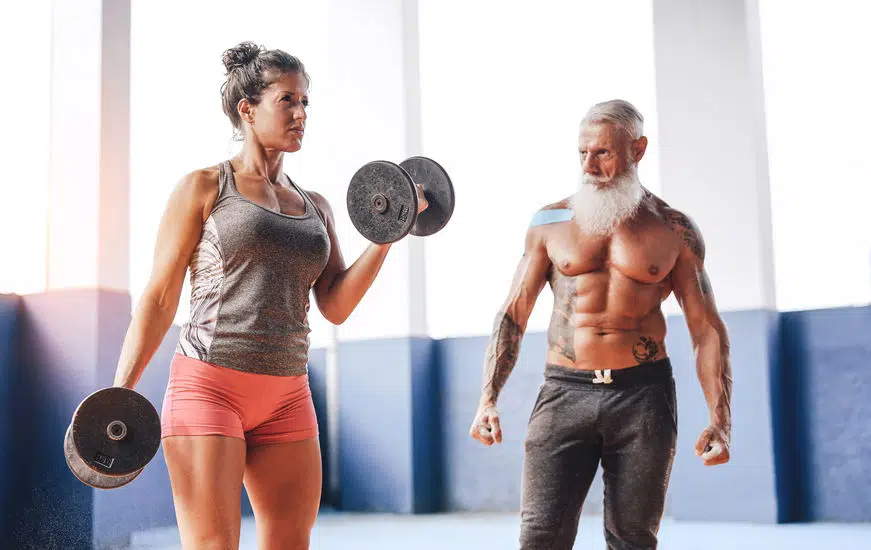
What follows is a highly effective dumbbell workout for your torso, consisting of 16 exercises done in circuits.
I encourage you to consult your physician before making significant changes to your fitness or nutrition.
The First Circuit (Warm-Up)
A circuit workout consists of a series of exercises performed one right after the other.
This workout consists of 5 circuits, each containing exercises to be done consecutively.
After moving through a particular circuit, take a 1-minute rest, and then repeat.
After completing a particular circuit your third time, you move on to the next circuit in the series.
Plank Knee-Pulls using a Stability Ball
The lower abdominals are one of the muscle groups that I believe most people are not training enough. Plank Knee-Pulls is an exercise that effectively targets the all-important lower abdominal muscles.
In the prone position, place your knees on a stability ball, and pull your knees up underneath your torso as you exhale, then slowly return to the starting position.
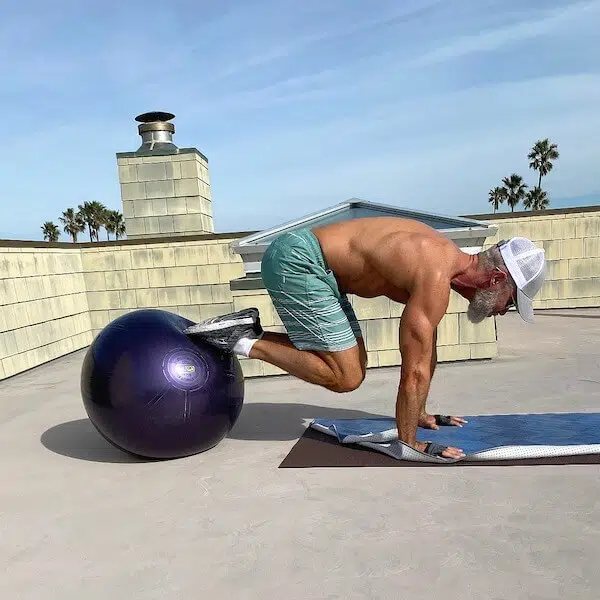
As you do this exercise, imagine initiating the movement not from your legs or hip flexors, but from the muscles of your lower abdomen. Imagine this area as an upside-down triangle above your pubic bone, and pull that lower abdominal plate firmly up to the sky – with intensity – each time you pull your knees in.
To protect your wrists, don’t allow your shoulders to come too far forward in front of your hands.
10 repetitions.
1-Minute Plank Hold on the Stability Ball
Instead of your feet on the stability ball, switch so that your elbows are now on the ball and your feet are on the ground. Hold a perfectly formed plank position for one full minute while you continue to breathe slowly.
Foward-and-Back Elbows While Planking (Stability Ball)
Begin in the same position as the previous exercise. Now start to move your elbows forward a few inches and back a few inches, which will roll the stability ball forward and back, too.
Keep breathing, and keep your abdominals fully engaged the entire time to protect your lower back.
10 reps.

1-Minute Jumping Rope
The key while jumping rope for a full minute is to keep your pelvis centered. (If your pelvis starts to tilt, your lower back will arch, which isn’t so good for your vertebrae or bladder while jumping).
Keep your spine tall, your chin slightly down, and your abs tights.
Your knees should remain a bit soft (not locked), and your feet should be slightly relaxed.
Be mindful about how you’re landing on the soles of your feet – not rolling in or out on the sides of your feet too much and not just bouncing off your toes.
The Second Dumbbell Circuit
Unlike the old days, dumbbells today can be adjustable, so you only need one pair. Hooray, technology!
My current favorite brand of dumbbell is made by Bowflex (see photo below). I like these because you can change the resistance with the turn of a dial.
Plus, the dumbbells come with their own stand.
These dumbbells are definitely one of the best purchases I ever made for my home gym (I’m not affiliated with the company; I just like this particular product).
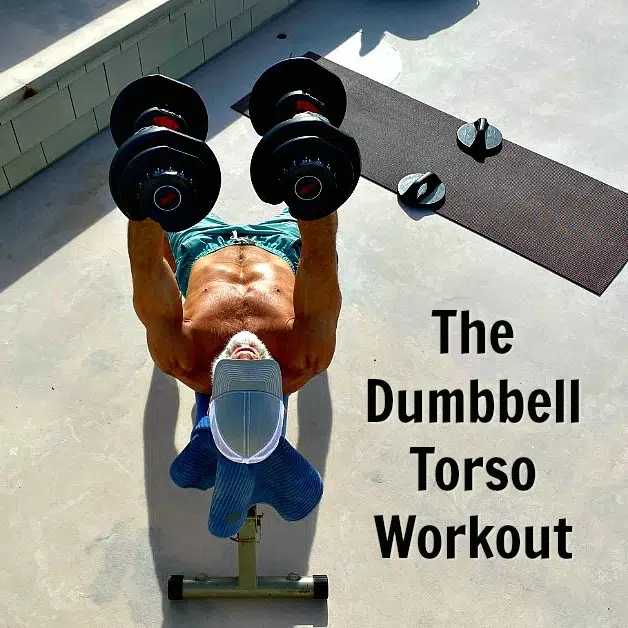
Incline Dumbbell Chest Press and Fly (Alternating)
This combines two exercises into one.
Set your bench to approximately a 45-degree incline as you press the dumbbells directly up over your shoulders, then open wide for a fly (elbows slightly soft) and bring the dumbbells back together over your neck. Then bend your arms down again and repeat the entire movement (see video).
This exercise targets the upper pectorals.
For those of you who, like me, are over 50, the upper pecs are particularly important to keep strong (I’m sorry to say that weakness in this area creates an unsightly drooping).
14 complete reps.

Incline Dumbbell Bicep Curl
Doing biceps curls on an incline bench is advantageous because it makes it harder to cheat using momentum. You’ll really feel those bicep muscles isolating.
I suggest concentrating on the quality of your muscular contraction. Squeeze those muscle fibers in the bicep at the top of each rep, then resist slowly on the way down (instead of dropping the hands quickly and taking the free ride).
10 reps.
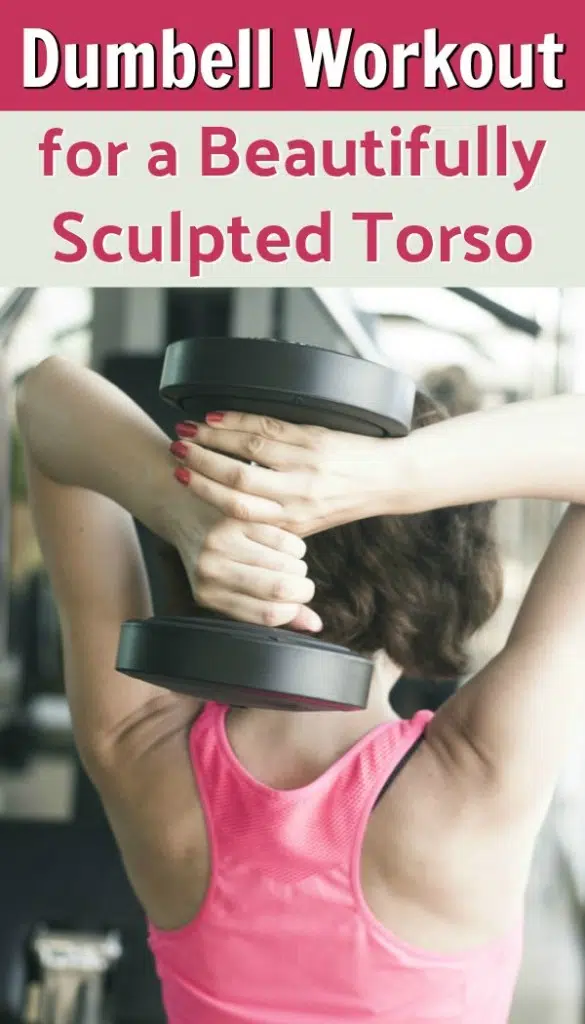
The Third Circuit
At this point in this circuit-training torso workout, you might feel tempted to take longer breaks between exercises or to let your mind wander a bit.
I encourage you to keep the pace brisk – if you can safely do so.
Keep awareness on the particular muscle group you’re trying to target during each exercise.
Push-Ups for Upper Chest
Place your feet up on a bench and your hands on the ground at about shoulder level. When you push, instead of just using your arms and shoulders – which is always the temptation – try to push from your pectorals instead.
12 reps.
Elbows-Out High Row and Low Rear Fly (Alternating)
This movement combines two exercises into one and helps to improve your posture and remedy the texting slouch that is so common today.
Back muscles targeted: rhomboids, lats, and posterior deltoids.
See video. And remember, try to initiate all movement from your back muscles and not just your arms.
16 reps.
Ball Push-Ups for Lower Inner Chest
Place your hands on a medicine ball and your feet on the ground and do push-ups – while squeezing your hands toward one another on the ball. This will target your inner chest.
Be mindful of your wrists. If it creates any discomfort in your wrists when you try to push-up from the ball, simply do close-grip pushups with your hands on the ground instead.
7 reps.
The Fourth Dumbbell Circuit
As you enter the fourth circuit of the workout, listen to the unique needs of your own body:
- You want to feel challenged, but not dizzy.
- Your muscles should feel taxed, but with no sharp pain in your elbows, shoulders, knees, and lower back.
- You should be breathing heavily, but without nausea.
- If it feels completely comfortable, you might need to choose heavier weights and shorten the rest period between circuits.
- If it feels horrible, you might need to dial-down the intensity a bit.
- Find the sweet spot.
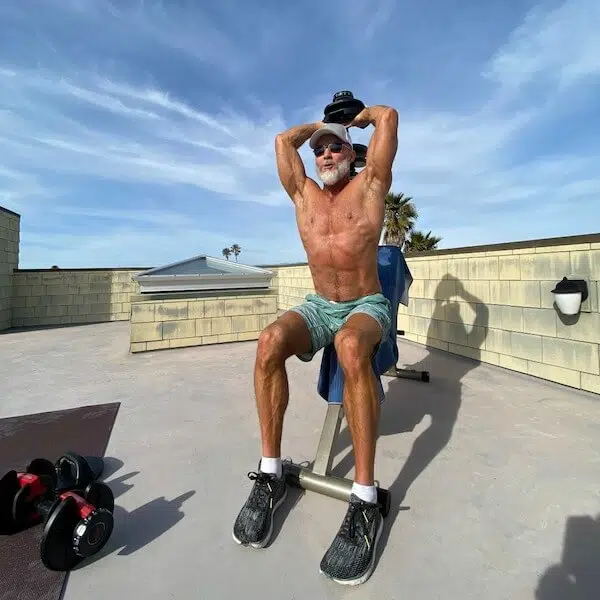
Seated Overhead Dumbbell Tricep Extensions
For most people, it’s probably best for their elbow joints to keep the elbows pointing forward instead of out to the sides.
Go slowly as you lower the dumbbell behind your head, and fast as you straighten your arms up to the return position.
Keep your navel pulled in tightly the entire time, and try not to let your lower back sway too much.
12 reps.
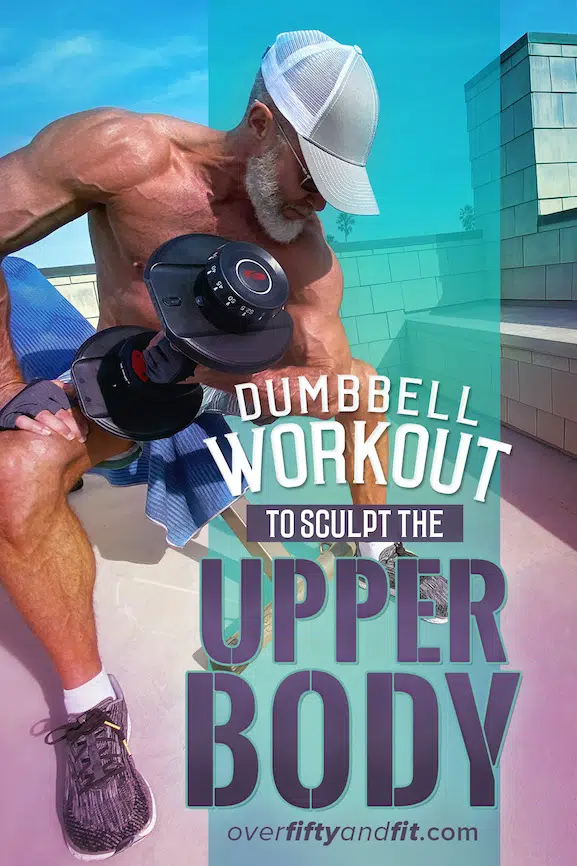
Dumbbell Concentration Curls
Sitting on a bench, engage your abdominal muscles as you lean forward and brace one elbow on the inside of the knee, rotating your spine a bit so that you’re leaning in at a slight diagonal.
Lower the dumbbell slowly, then quickly up to the starting position as you intensely contract the muscle fibers of your biceps.
12 reps.
The Final Dumbbell Circuit
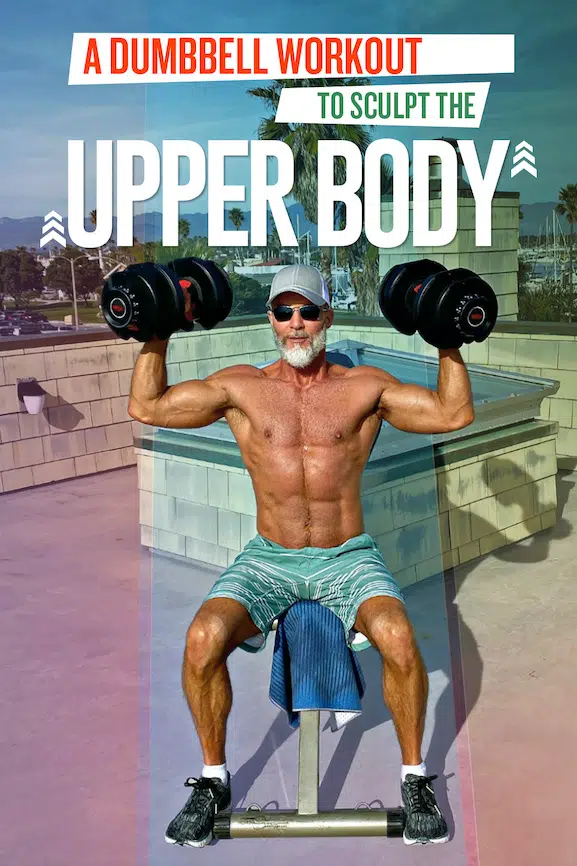
Overhead Dumbbell Press
Go slowly on these, and listen to the needs of your shoulder’s ball-and-socket joint. It might feel good to subtly rotate your arms so that your palms face out at the top and rotate your arms so that your palms face in at the bottom.
Navel pulled in tightly for protection, and avoid swaying your lower back. It also helps to drive the soles of your feet into the ground as you press your arms overhead.
8 reps.
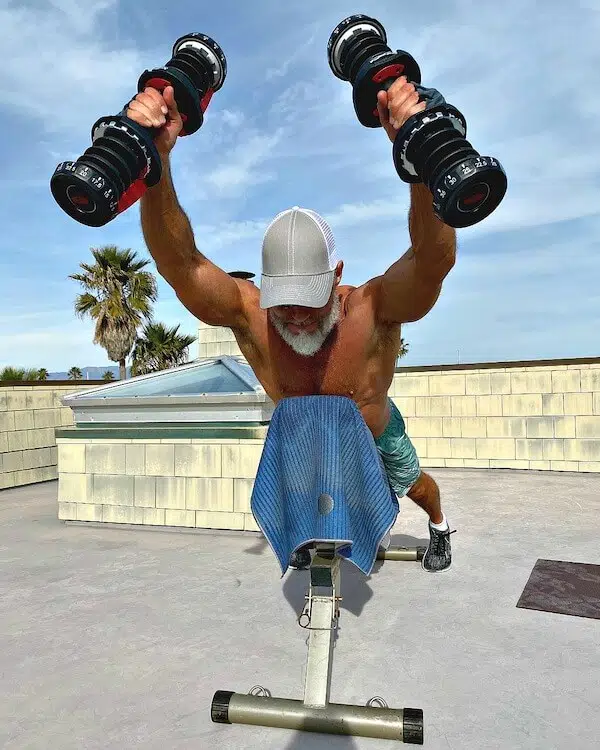
Prone Front Arm Raise and Rear-Delt Fly (Alternating)
Two exercises combined, this movement trains the posterior chain of your body’s muscles. The trick is to keep your pelvis “mating” into the incline bench to protect your lower back (see video).
Dumbbell Circuit Training, for the Win!
The idea behind circuit training, as outlined in this torso dumbbell workout, is simple: to become a truly active person.
Most people think of themselves as more active and healthier than they actually are.
Essentially, we’re all underestimating how sedentary our modern lifestyles have become, and circuit-training workouts make an excellent antidote to this problem of under-activity.
Consistently participating in circuit-training workouts will increase your body’s ability to burn fatty fuels while at rest and improve your body’s ability to balance its own production of biochemicals.
By exercising in a highly consistent way, you protect or improve your body’s mitochondria – the power plants inside your cells that create energy – staving off age-related diseases.
As a bonus, dumbbell circuit training can also significantly improve your appearance.
Dumbbells are often preferred over other types of weightlifting equipment because they allow for greater freedom of movement and can be used for unilateral exercises, which can help to identify and address muscle imbalances. Additionally, dumbbell exercises can be performed in a seated or standing position, making them accessible for people with a variety of fitness levels and mobility limitations.
Overall, dumbbells are a popular and effective piece of exercise equipment for improving muscular strength, endurance, and overall fitness.
